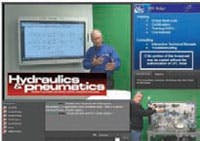A cruise ship was having problems docking after a cruise. If strong winds were blowing outward from the dock, the bow thrusters that moved the ship sideways weren’t powerful enough to move the ship against the wind to the dock. The captain would approach the dock going forward and at an angle that allowed him to engage the dock but it made for a rough landing.
A more powerful system was ordered and installed. The smaller open loop hydraulic system was replaced with a higher-powered hydrostatic closed loop system. A more powerful diesel engine was installed with new 2 in. schedule 80 piping that ran about 100 ft both fore and aft. The original 75 gal fuel oil tank was then reused for the system’s reservoir. It had unused return connections close to the top for the extra return lines needed.
| Find the solution |
|
Think you know the answer? You can submit solutions by e-mailing [email protected]. All correct solutions will be entered for a chance at a $50 gift card — we will randomly select a winner from all correct answers. The winner will be notified, and his or her name will be printed in the next edition of Troubleshooting Challenge. Congratulations to Harold Curtis, design engineer with Curtis Controls, Douglasville, Ga., who was the only person to submit the correct answer for our September Troubleshooting Challenge. The correct answer will be published in the next edition of “Troubleshooting Challenge” and also at blog.hydraulicspneumatics.com. |
The new system was commissioned and used two or three times when it had a major failure destroying both the pump and motor. The units were returned to the original manufacturer for evaluation and repair. The failure report indicated contamination problems as the main cause of failure, but listed signs of overspeeding, lack of lubrication and lack of sufficient charge pump pressure as other signs for failure causes.
The repaired pump and motor were reinstalled and the system was flushed and cleaned to an ISO particle count better then the manufacturer’s recommendation. The charge pump was changed to a double pump so a “kidney loop” filter system could be installed. The air was bled out as best as possible and the system put back into service. Gauges were installed, and the motor return line pressure was 400 psi while the pump inlet showed 250 psi. System pressure was limited to 3000 psi, even though the pump and motor were rated for 4500 psi.
After several cruise trips, the system failed again, as before. Whatever was causing the problem apparently still existed. The failed units showed the same results: brass transfer at the saddle bearings, typical piston lift off (signs of low charge pump pressure), and contamination particles more than likely were from the broken parts in the pump and motor.
The schematic of the system is typical of a popular design and set-up. The main pump could produce 130 gpm, the charge pump was a 28 gpm unit with the charge pump relief set at 250 to 300 psi, a 75 gal fuel oil tank, and a flushing, (hot oil) shuttle valve/relief circuit.
Any ideas what the problem was?
Robert J. Sheaf Jr., is the founder of Certified Fluid Consultants (CFC) and President of CFC-Solar Inc. CFC-Solar provides technical training, consulting, and field services to any industry using fluid power technology. Visit www.cfcsolar.com for more information.
Mobile Equipment Training Challenges
Industries such as energy, mining, construction, rail, waste management, agriculture, and oil and gas are loaded with mobile equipment. If you are faced with finding professional training for your fleet or unique mobile equipment, CFC Solar may be able to help. CFC-Solar is one of the most respected names in the mobile industrial training market with a history of developing training programs that teach individuals how to maintain today’s technically advanced mobile equipment. In addition to product specific training, CFC-Solar has standard training classes developed for the mobile industry that include:
- Level 1 Mobile Hydraulics – In Depth Fundamentals
- Level 2 Mobile Hydraulics – Advanced Maintenance
- Level 3 Mobile Hydraulics – Design and Sizing
- Troubleshooting Mobile Systems using Schematics
- Hydrostatic Closed Loop Systems
- Level 1 Mobile Electrical – Fundamentals
- Level 2 Mobile Electrical – Multiplex Systems
CFC-Solar is one of the primary training firms that provide Fluid Power Society Mobile Hydraulic Certification. For more information, contact [email protected] or visit www.cfc-solar.com.


